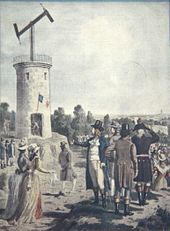Claude Chappe
Claude Chappe | |
|---|---|
telecommunications |
Claude Chappe (French:
Early life

Claude Chappe was born in Brûlon,
His uncle was the astronomer Jean-Baptiste Chappe d'Auteroche, famed for his observations of the Transit of Venus in 1761 and again in 1769. The first book Claude read in his youth was his uncle's journal of the 1761 trip, "Voyage en Siberie". His brother, Abraham, wrote "Reading this book greatly inspired him, and gave him a taste for the physical sciences. From this point on, all his studies, and even his pastimes, were focused on that subject." Because of his astronomer uncle, Claude may also have become familiar with the properties of telescopes.[2]
He and his four unemployed brothers decided to develop a practical system of semaphore relay stations, a task proposed in antiquity, yet never realized.[3]
Claude's brother, Ignace Chappe (1760–1829) was a member of the Legislative Assembly during the French Revolution. With his help, the Assembly supported a proposal to build a relay line from Paris to Lille (fifteen stations, about 120 miles), to carry dispatches from the war.

The Chappe brothers determined by experiment that the angles of a rod were easier to see than the presence or absence of panels. Their final design had two arms connected by a cross-arm. Each arm had seven positions, and the cross-arm had four more, permitting a 196-combination code. The arms were from three to thirty feet long, black, and counterweighted, moved by only two handles. Lamps mounted on the arms proved unsatisfactory for night use. The relay towers were placed from 12 to 25 km (10 to 20 miles) apart. Each tower had a telescope pointing both up and down the relay line.
Chappe initially called his invention a tachygraph ("fast writer").
In 1794, the first messages were successfully sent between Paris and Lille.[6] In 1794 the semaphore line informed Parisians of the capture of Condé-sur-l'Escaut from the Austrians less than an hour after it occurred. Other lines were built, including a line from Paris to Toulon. The system was widely copied by other European states, and was used by Napoleon to coordinate his empire and army.[6]
In 1805, Claude Chappe killed himself.[10] He was said to be depressed by illness, and claims by rivals that he had plagiarized from military semaphore systems.

In 1824 Ignace Chappe attempted to increase interest in using the semaphore line for commercial messages, such as commodity prices; however, the business community resisted.
From 1844, the government of France funded trials of a new system of
Popular culture
The Chappe semaphore figures prominently in Alexandre Dumas' The Count of Monte Cristo. The Count bribes an underpaid operator to transmit a false message.
Memorials

Rue Chappe in the
See also
References
- ^ "Lycée Pierre Corneille de Rouen - The Lycée Corneille of Rouen". lgcorneille-lyc.spip.ac-rouen.fr. Retrieved 1 May 2018.
- ^ "The Early History of Data Networks". people.seas.harvard.edu. Archived from the original on 1 April 2017. Retrieved 1 May 2018.
- ^ "Claude Chappe". Retrieved 8 May 2024.
- ^ Beyer, p. 60
- ^ Le Robert historique de la langue française, 1992, 1998
- ^ a b c French source: Tour du télégraphe Chappe Archived 28 September 2011 at the Wayback Machine
- ^ Groundbreaking Scientific Experiments, Inventions & Discoveries of the 18th Century, Jonathan Shectman, p. 172
- ^ Oxford English Dictionary.
- ^ Webster's Unabridged Dictionary.
- ^ "Claude Chappe (French engineer)". Encyclopædia Britannica. Archived from the original on 25 June 2009. Retrieved 7 August 2009.
- ISBN 0818667826.
- ^ Booking.com, Sacré Coup de Cœur - Studio, accessed 22 January 2023
- ^ "Where the Statues of Paris were sent to Die". messynessychic.com. 7 January 2016. Archived from the original on 19 March 2018. Retrieved 1 May 2018.
Bibliography
- Beyer, Rick, (2003) The Greatest Stories Never Told, Harper Collins, ISBN 0-06-001401-6
- ISBN 0818667826
- Standage, Tom, (1998) The Victorian Internet, Bloomsbury Publishing, ISBN 978-1-62040-592-5
External links
- French article: Les Télégraphes Chappe, l'Ecole Centrale de Lyon
- French article: Le télégraphe aérien, in Les merveilles de la science, de Louis Figuier, t. 2, pages 20–68
- Italian article: Francesco Frasca, Il telegrafo ottico dalla Rivoluzione francese alla guerra di Crimea, in Informazioni della Difesa, n°1, 2000, Roma: Stato Maggiore della Difesa, pp. 44–51
